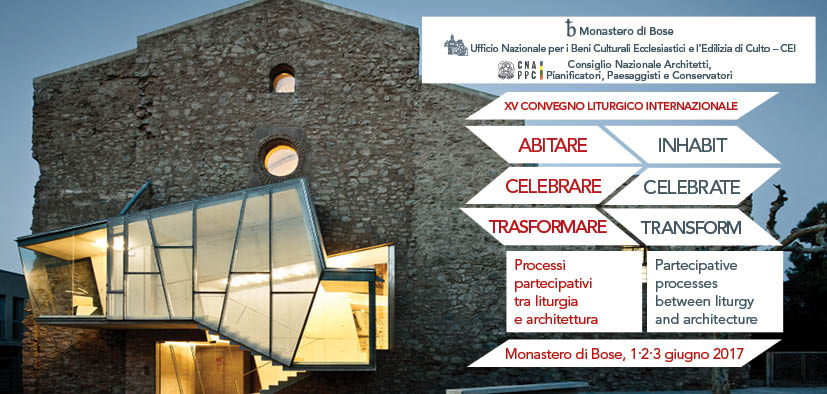Research Project and Scientific Committee
XVth International Liturgical Conference
INHABIT
CELEBRATE
TRANSFORM
participative processes between liturgy and architecture
Bose, 1–3 June 2017
/PROJECT/
“A grammar for imagining and living the Church through its spaces and its architecture” is the theme of the XVth International Liturgical Conference of Bose. It aims at bringing out the participative dimension of church and architectural experience, in an exchange between the commissioning party, architects, artists, and the Christian community. In fact, it is not possible to imagine and create the spaces of a church without involving the persons and communities called to inhabit the places of the Church’s life, in a profound synergy with the neighboring social and environmental setting. The grammar tires to conjugate the verbs
/MAKE/ in the ecclesiological perspective of “making the Church” and “making churches” in the architectural sense. There is always a community on the local level at the origins of a building, which must confront the desire, the challenge, and the necessity of building, transforming, and inhabiting a church building in an age of non-belonging or of fluid belonging, elective or immaterial, and not necessarily physically close in space. How can the new needs of a community be conjugated with architecture?
/INHABIT/ from the anthropological and philosophical angle of dwelling in a built space. If “inhabiting is the mode of mortals on earth” (Heidegger), then this modality must be thought out and in a specific social intermingling and context, in an age of non-places. What are the ways to listen to a territory and to respond to the real needs of a community? How can one achieve that inhabiting means “taking care” in Heidegger’s sense?
/CONSTRUCT/ that is, put a new element within a landscape. In the architectural and theological sense, the Church is a constructor of time and space, knowing that to construct is that authentic inhabiting that, while it raises buildings, takes care of that rises. Gathering together the living stones of a spiritual edifice, the church community forms out of itself spaces and materials, volumes and lights, emptiness and fullness. How can a space be cut out for inhabiting and taking care of the spirit?
/CELEBRATE/ in a theological key, implies assuming and living rituality and spirituality in a place. The liturgical action of a celebrating community shapes the spaces, impresses a direction, opens ways of sense and sensitivity, manifests the Church, while giving it form. Today, to celebrate implies answering the need of rites for starting out on an itinerary of faith. To celebrate is the end of building and the fullness of inhabiting.
/TRANSFORM/ that is, give new life to places. Every space built by man is a living organism and for this reason in continuous transformation, authentic change of finalities, usages, and forms. The Church is semper reformanda also in its architecture. The church tradition, which is a transmission of fire and not a nostalgia of ashes, inhabits and lives community spaces in its continual transformations, hence inevitably it transfigures them, so that they may continue to be today’s eloquence of God for the men and women who live the Church’s today in the world’s today. To give new life to things is not only a task of the divine, but needs the contribution of the human.
The Conference will be preceded by a workshop of 20 young researchers who will discuss its themes, sharing projects and case studies. The material and questions that will come out of this will be a topic of discussion among the participants of the conference.
/SCIENTIFIC COMMITTEE/
Enzo Bianchi (Bose), Valerio Pennasso (Rome), Emanuele Borsotti (Bose), Goffredo Boselli (Bose), François Cassingena-Trévedy (Paris), Mario Cucinella (Bologna), Bert Daelemmans (Madrid), Albert Gerhards (Bonn), Angelo Lameri (Rome), Andrea Longhi (Turin), Philippe Markiewicz (Paris)
